

Sephirot. Sephirot (/sfɪˈroʊt/, /ˈsfɪroʊt/; Hebrew: סְפִירוֹת Səphîrôṯ), meaning emanations, are the 10 attributes/emanations in Kabbalah, through which Ein Sof (The Infinite) reveals himself and continuously creates both the physical realm and the chain of higher metaphysical realms (Seder hishtalshelus).
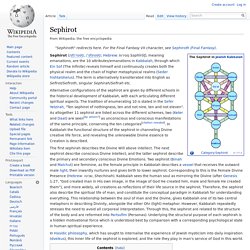
The term is alternatively transliterated into English as Sefirot/Sefiroth, singular Sephirah/Sefirah etc. Alternative configurations of the sephirot are given by different schools in the historical development of Kabbalah, with each articulating different spiritual aspects. The tradition of enumerating 10 is stated in the Sefer Yetzirah, "Ten sephirot of nothingness, ten and not nine, ten and not eleven". As altogether 11 sephirot are listed across the different schemes, two (Keter and Daat) are seen[by whom?] As unconscious and conscious manifestations of the same principle, conserving the ten categories[citation needed]. Ten Sephirot[edit] Listings[edit] Description[by whom?] [edit] Notes[edit] Semitic Roots Repository - View Word. Šiin - arabic hebrew lexicon. ArabTeX. The ArabTeX logo ArabTeX is a free software package providing support for the Arabic and Hebrew alphabets to TeX and LaTeX.

Written by Klaus Lagally, it can take romanized ASCII or native script input to produce quality ligatures for Arabic, Persian, Urdu, Pashto, Sindhi, Shahmukhi Punjabi, Maghribi, Uyghur, Kashmiri, Hebrew, Judeo-Arabic, Ladino and Yiddish. ArabTeX characters are placed within a TeX/LaTeX document using the command \RL{ … } or the environment \begin{RLtext} … \end{RLtext}. ArabTeX is released under the LaTeX Project Public License v1+.[1] Example[edit] \novocalize \RL{al-salAm `alaykum} \documentclass[12pt]{article} \usepackage{arabtex} \begin{document} \setarab \fullvocalize \transtrue \arabtrue \begin{RLtext} bismi al-ll_ahi al-rra.hm_ani al-rra.hImi \end{RLtext} \end{document} Common commands[edit] \setarab (set language specific rendering)\setfarsi (set language specific rendering)\setuighur (set language specific rendering)\set...
Character table[edit] See also[edit] Persian alphabet, pronunciation and language. The Persian language has been written with a number of different scripts, including the Old Persian Cuneiform, Pahlavi, Aramaic, and Avestan, Cyrillic and Latin alphabets.
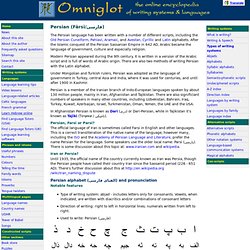
After the Islamic conquest of the Persian Sassanian Empire in 642 AD, Arabic became the language of government, culture and especially religion. Modern Persian appeared during the 9th century. It is written in a version of the Arabic script and is full of words of Arabic origin. There are also two methods of writing Persian with the Latin alphabet. Under Mongolian and Turkish rulers, Persian was adopted as the language of government in Turkey, central Asia and India, where it was used for centuries, and until after 1900 in Kashmir. Persian is a member of the Iranian branch of Indo-European languages spoken by about 130 million people, mainly in Iran, Afghanistan and Tajikistan. In Afghanistan Persian is known as Dari (درى) or Dari-Persian, while in Tajikistan it's known as Tajiki (Тоҷики / تاجيكى).
Iran or Persia? Notes. Www.sid.ir/en/VEWSSID/J_pdf/12392000601.pdf. Cipher. News : The meaning of sefer, sofer and safari. For Jews, books and reading are an essential part of our culture and faith.
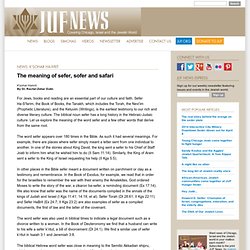
Sefer Ha-S’farim, the Book of Books, the Tanakh, which includes the Torah, the Nevi’im (Prophetic Literature), and the Ketuvim (Writings), is the earliest testimony to our rich and diverse literary culture. The biblical noun sefer has a long history in the Hebraic-Judaic culture. Let us explore the meaning of the word sefer and a few other words that derive from the same root. The word sefer appears over 180 times in the Bible. As such it had several meanings. In other places in the Bible sefer meant a document written on parchment or clay as a testimony and remembrance.
The word sefer was also used in biblical times to indicate a legal document such as a divorce written to a woman. The biblical Hebrew word sefer was close in meaning to the Semitic Akkadian shipru, which meant a letter or a message and derived from the verb shaparu meaning to send a message or to write a letter. Al-Ṣifr - Brill Reference. (a.), a term which appears in Arabic dictionaries with the meaning of “void” and, by extension, of “zero”.
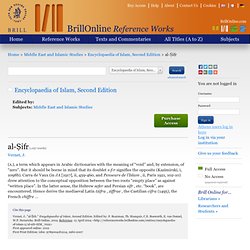
But it should be borne in mind that its doublet s-f-r signifies the opposite (Kazimirski, i, 1098b). Carra de Vaux (in JA [1917], ii, 459-460, and Penseurs de l’Islam , ii, Paris 1921, 102-10) drew attention to the conceptual opposition between the two roots “empty place” as against “written place”. Balashon - Hebrew Language Detective. The Ancient Hebrew Letters. There are several possibilities for the original Semitic pictograph including (a fish), (possibly a thorn), (a window?)
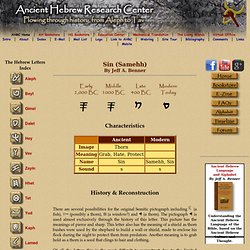
And (a thorn). Is used almost exclusively through the history of this letter. Of all the letters this is the most difficult to reconstruct due to the limited archeological and textual support. The original sound for this letter must be an "s" to which the samech and sin both agree.